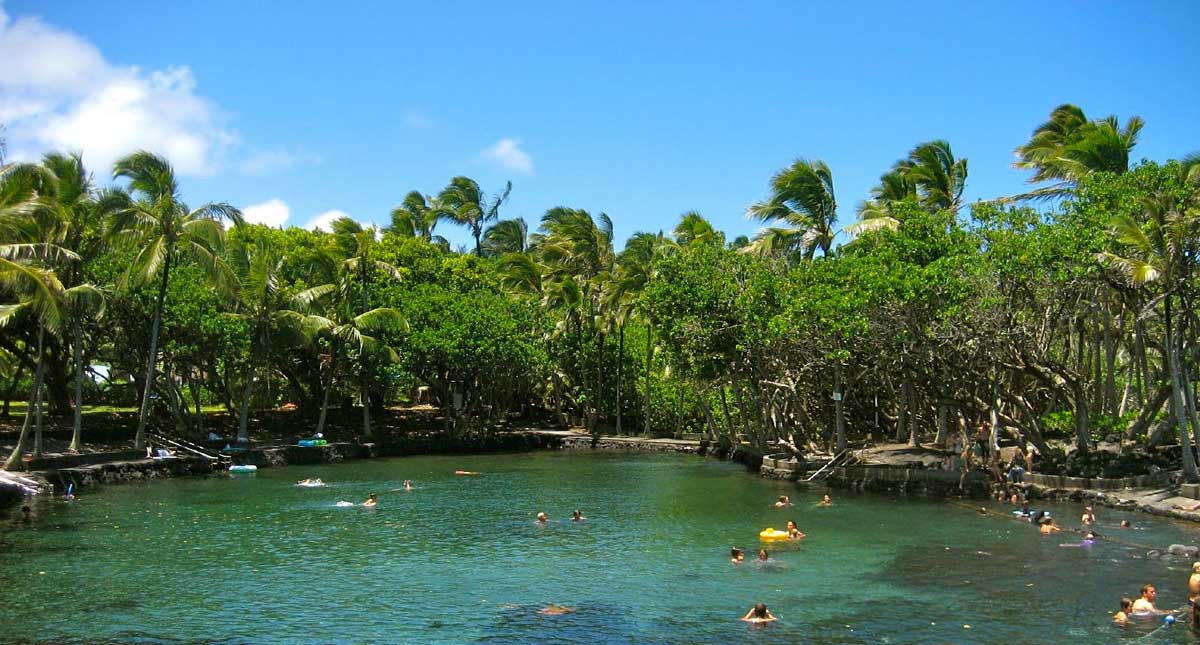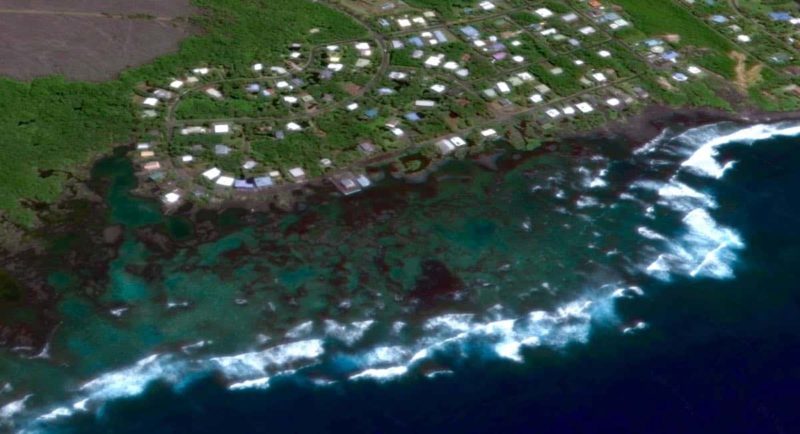After several recent volcanic eruptions there remains but one easily accessible hot pond in the Puna district.
Visiting hot springs is an excellent addition to your itinerary, especially if you are staying more than 7 days here on the Big Island. In our guide to hot springs on the Big Island you can find the following information:
Table of contents
- Why are our hot ponds warm?
- List of Hot ponds
- The Pohoiki hot springs
- The Ahalanui warm ponds (overrun by lava the 11th of July 2018)
- The Kapoho Tide Pools (overrun by lava the 4th of June 2018)
- Finally, stay safe! Important pointers on hygiene
Table of Contents
- Why are our hot ponds warm?
- List of Hot ponds
- The Pohoiki hot springs
- The Ahalanui warm ponds (overrun by lava the 11th of July 2018)
- The Kapoho Tide Pools (overrun by lava the 4th of June 2018)
- Finally, stay safe! Important pointers on hygiene
Please be aware that bathing in the hot springs while having broken skin is not advised. Read more about possible hygiene concerns here.
What makes Hot Springs, hot?
Have you ever wondered what it would be like to sit in a warm pool that is heated by volcanic energy? From personal experience I can tell you that it is pretty great, especially if you think about what makes the water warm!
It rains a lot on the windward (East) side of the Big Island, up to 300 inches (10 meters) per year. Most of this water does not flow directly to the ocean but sinks down into the ground until it hits a barrier. On the Big Island this barrier is made out of salt water which is heavier than fresh water. The water in this layer then slowly dissipates to the edge of the island and flows into the ocean.
In the volcanic area’s on the Big Island, the water flows through rocks that are heated by magma. This heat is absorbed by the water and taken along to the coast. As the water moves away from the magma it cools down a bit (especially if cold water mixes in), but the water stays warm enough to give the visitors of the Big Island a comfortable warm bath!
One popular hot spring on the Big Island
Warm water heated by underground lava from the lower eastern rift zone springs wells up from the ground in springs commonly found along the Puna coast from Cape Kumukahi to `Opihikao. The two most popular and accessible hot ponds were covered by lava during the 2018 eruption of the Kilauea volcano in the lower Puna district (more info), and the same eruption has led to the creation of another, now, warm spring.
- The Pohoiki hot springs
- The Ahalanui warm ponds (overrun by lava the 11th of July 2018)
- The Kapoho Tide Pools (overrun by lava the 4th of June 2018)
Pohoiki warm/hot springs
The Pohoiki warm springs are part of the Isaac Hale Beach Park in Puna.
The 2018 LERZ eruption has changed Pohoiki Beach Park significantly and now it is home to the newest black sand beach on the Big Island! This is a beautiful beach and well worth a visit.
The eruption also created several natural thermal ponds which are contained by all the new black sand that trap heated spring water. As the heat from the 2018 LERZ lavaflow propagates underground the water in these ponds has been getting warmer and warmer, making them now the newest natural volcanically-heated ponds on the island. You can read more about the heating up of the springs at Pohoiki at the Hawaii Tracker website.
There are 5 warm to hot springs at Pohoiki, shown on the image below. These are:
- A pond adjacent to the lava flow on the far eastern edge of the beach
- A pond that has formed at the location of the old boat ramp
- A pond at intersection of the new beach with the old coastline at the previous location of ‘1st bay’
- The previously already existing warm pond in the forest that has now heated up more
- A pond at intersection of the new beach with the old coastline at the previous location of ‘2nd bay’
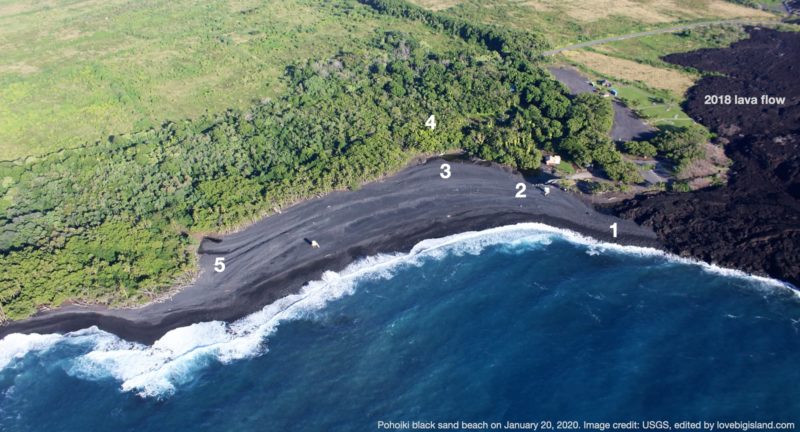
The 5 hot springs at Pohoiki. In this aerial picture of the new black sand beach at the Isaac Hale Park taken on 21 January 2020 you can see that the basaltic sand from the 2018 lava delta (right) continues to accumulate, both widening and elongating the beach in Pohoiki Bay. Image credit: USGS (public domain)
Important: the Department of Health warns that these ponds are not disinfected and that, due to the risk of bacterial infections, the public should not enter these ponds if they have open wounds. Enter these ponds at your own risk.
Ahalanui Warm or Hot Pond (closed)
Ahalanui park is the park built around the Ahalanui warm pond. There is a picnic area, showers, and toilet facilities. It is a popular destination for locals, and especially during the weekend the place gets crowded. It is best to visit during the week and to arrive early in the morning (before 9 a.m.) to avoid the crowds.
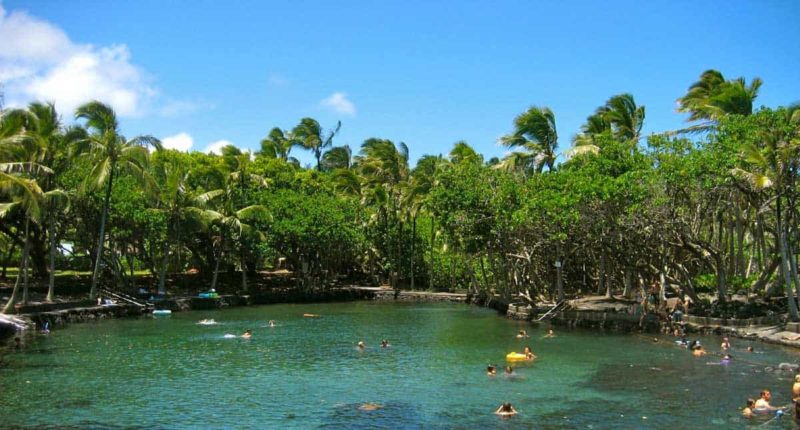
The Ahalanui hot Ponds in the Puna district on the Big Island, Hawaii. The pool is partly walled off from the Ocean to create a lukewarm swimming pool.
The Kapoho tide pools (closed)
The Kapoho tide pools go by the official name of the Wai‘ōpae Tide pools Marine Life Conservation District. They are located about 1.5 miles north of the Ahalanui warm pond. (Wai‘ōpae means “shrimp water” in the Hawaiian language)
The Kapoho tide pools are a beautiful but difficult to reach snorkeling spot in Kapoho bay that is praised in almost every guidebook. Some of the ponds are heated by warm water seeping out of the lava rocks and into the pools, which explains why this great snorkeling spot made it into our list of Big Island hot springs.
The tide pools are protected from the waves by a basalt ridge just off shore and get flushed out with fresh water twice a day as the tide comes in. Inside this natural wall you can find a maze of tide pools to explore. These conditions are ideal for coral growth and the Kapoho tide pools host one of the most diverse and highest coral covers as far as east Hawai‘i reefs go.
Those are the good things about the Kapoho tide pools. There are, however, also some complications:
- The tide pools front the residential Kapoho Vacationland subdivision, and there is no public parking available. Visitors to the tide pools must park at the entrance to the subdivision near the mailboxes and walk to the tide pools, a distance of roughly half a mile.
- There are no lifeguards on duty at the tide pools and public facilities are minimal: one portable toilet.
- There is also the issue of sanitation. Sewage from the residential units can leak through the water table into the tide pools. Water quality measurements found that DOH safety standards were exceeded in most tide pools (source). Don’t enter the water if you have a break in your skin, and read on for more information on hygiene and hot ponds.
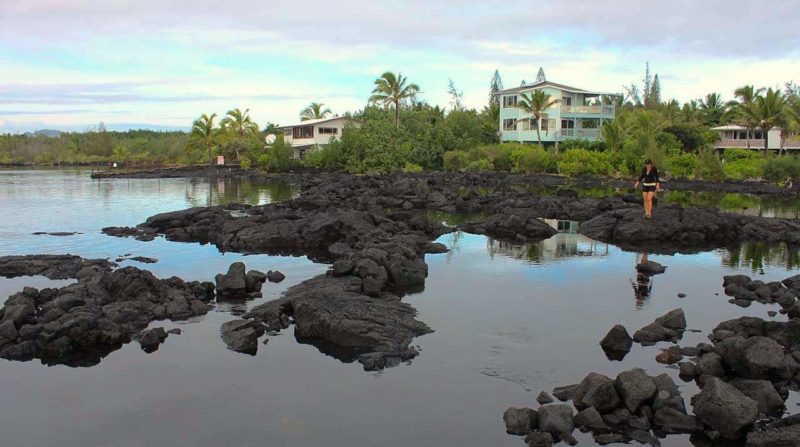
The Kapoho tide pools are located in front of the Kapoho vacationland subdivision. USA – Hawaii / Big Island: Kapoho Tide Pools, CC BY-SA 2.0, Link
Read more about the Kapoho (Wai‘ōpae) tidepools at the hawaii.gov website.
You can get an impression of the Kapoho tide pools from the following video:
Hygiene issues for Big Island Hot Ponds
There are some hygiene concerns about the hot ponds on Hawaii. It is not unusual that the bacterial count in the hot ponds exceeds the EPA and state guidelines (source). This is mostly caused by the combination of poor sanitation in the area and large visitor numbers.
There are hundreds of people (including many tourists) using the ponds each day that are not affected, but, as a tourist, you are more likely to be vulnerable to the local bacterial population. The best way to stay safe when visiting the hot ponds is to use common sense:
- Don’t enter the water if you have an open cut or infection.
- Avoid crowds: stay away during the weekends and visit early in the morning when the ponds have been flushed overnight by tides.
- Take a shower after you get out of the water and rub yourself clean.
You can find water quality advisories for the state of Hawaii here.
